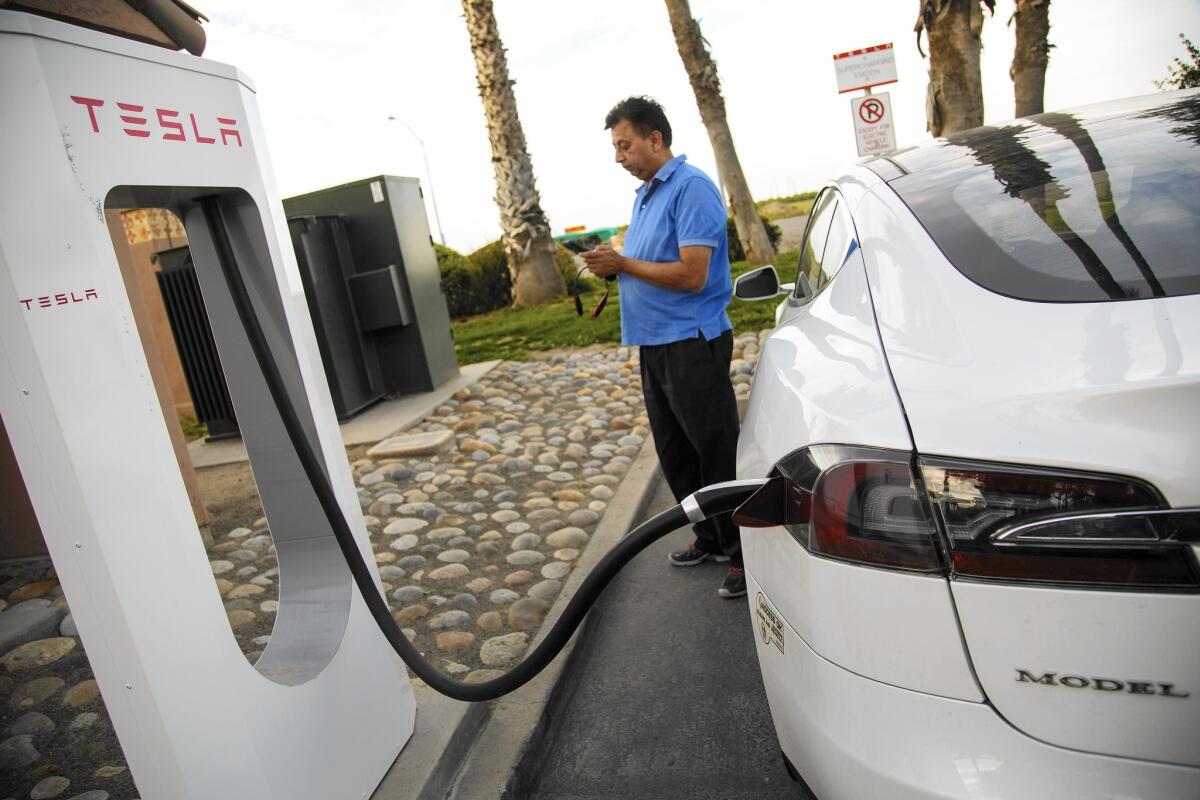Why the Tesla and electric car boom could be good news for the grid

- Share via
Earlier this year, breathtaking numbers of pre-orders for the Tesla Model 3 not only shocked the auto industry, but also suggested that a transition of the U.S. and world auto fleet toward electric vehicles could happen faster than expected.
There are still only a little more than 400,000 electric vehicles on the road in the U.S., or just 0.16 percent of all cars. But predicted growth rates could have them at more than a third of new car sales globally by 2040, according to Bloomberg New Energy Finance.
As the cars and their batteries get cheaper, they’ll become more and more accessible to buyers — even as a profusion of charging stations to service growing numbers of vehicles will help address the so-called “range anxiety.” These trends, combined with climate-change concerns, all presage a bright future for the electric car.
All of which means that at some point, this trend could start to have key implications for the entire electricity system, says a new report released Wednesday from the energy think tank The Rocky Mountain Institute.
An electric vehicle with a 30-kilowatt-hour battery, the report notes, “stores as much electricity as the average U.S. residence consumes in a day.” It adds that if all U.S. light duty cars suddenly became EVs, “they would require about 1,000 [terawatt hours] of additional electricity per year, or an increase of about one-quarter of our current electricity demand.”
Clearly, a lot of EVs means a lot of electricity use. In particular, if large numbers of EVs are charging at roughly the same hour of day — and that time of day is likely to be when people get home from work, which is when electricity use spikes already — the repercussions could be massive. Electricity is most expensive during these peak hours, and power companies have to fire up so-called “peaker plants,” usually driven by natural gas, to slake demand.
See the most-read stories in Business this hour »
“If it increased the peak, we would have to invest more money for more generation capacity for the peak, which is the most expensive kind of generation capacity,” says the Rocky Mountain Institute’s Chris Nelder, one of the authors of the report.
This is either a huge coming problem — or a huge opportunity. The Rocky Mountain Institute report sees it as the latter.
The idea is that if we can find ways to shift when this growing fleet of electric vehicles charge up — either toward daylight hours, when they’re more likely to be powered by solar, or to overnight hours, when electricity is cheap — then it opens up a number of options and efficiencies. The result, the report says, could actually be more renewables on the grid, fewer greenhouse gas emissions and cheaper electricity prices.
“Instead of investing in this peak capacity, we want to shift that charging so that it happens in the middle of the night when you’ve got baseload capacity sitting there running,” says Nelder. The result, he says, could “actually optimize the use of all the other assets on the grid. And in so doing, it could actually reduce the per kilowatt-hour cost of electricity.”
Chris Mooney writes for the Washington Post.
ALSO
BMW wins LAPD electric car contract, beating Tesla
Karma comes around again: California’s newest car factory aims to rival Tesla
Faraday Future seeks approval to build electric cars in California
More to Read
Inside the business of entertainment
The Wide Shot brings you news, analysis and insights on everything from streaming wars to production — and what it all means for the future.
You may occasionally receive promotional content from the Los Angeles Times.










